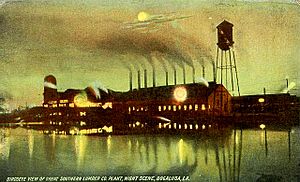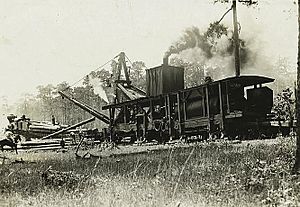Great Southern Lumber Company facts for kids
| Successor | Gaylord Container Corporation |
|---|---|
| Founded | 1902 in Pennsylvania |
| Founder | Frank Goodyear Charles W. Goodyear |
| Defunct | 1938 |
| Headquarters |
,
United States
|
|
Key people
|
Anson Goodyear William H. Sullivan |
| Products | Longleaf pine |
| Subsidiaries | New Orleans Great Northern Railroad Bogalusa Paper Company Bogalusa Turpentine Company Bogalusa Tung Oil |
The Great Southern Lumber Company was a big company started in 1902. Its main goal was to cut down and sell the huge longleaf pine trees in southeastern Louisiana and southwestern Mississippi. The company built a whole new town called Bogalusa, Louisiana just for its workers. This town was also home to the company's giant sawmill, which opened in 1908. The Great Southern Lumber Company also owned a railroad and a paper mill. It stopped working in 1938 because all the old, big pine trees were gone. Bogalusa then became a center for paper and chemical factories.
Contents
A Look Back: Company History
In the late 1800s, two brothers, Frank and Charles W. Goodyear, became very rich. They invested in timberlands, sawmills, coal, and railroads in Pennsylvania and New York. Their secret to success was buying large areas of forest that seemed impossible to reach. These lands were far from rivers, which were usually used to float logs to sawmills. To get to these trees, the Goodyears built special railroad tracks and local sawmills. This allowed them to process the trees into lumber.
Between 1901 and 1905, the brothers spent $9 million. They bought 300,000 acres (about 1,200 km²) of untouched yellow pine forests. These lands were in Louisiana and Mississippi, near the southern end of the Pearl River. On January 17, 1902, the Goodyear brothers officially started the Great Southern Lumber Company in Pennsylvania.
The brothers began building the huge sawmill in southeast Louisiana. They also created the company town of Bogalusa for their workers. To bring the cut trees to the sawmill and send the finished lumber to markets, the Goodyears started the New Orleans Great Northern Railroad. This railroad connected Bogalusa to the main railroad system across the country.
The Goodyear brothers did not live to see their big southern project finished. Frank Goodyear passed away in 1907, and Charles Goodyear died in 1911. Even with tough economic times, the Great Southern Lumber Company sawmill started working in 1908. Younger members of the Goodyear family took over the company's leadership roles.
The Giant Sawmill
The Great Southern Lumber Company sawmill was designed to process a huge amount of wood. It could handle 1,000,000 board feet (about 2,400 cubic meters) of lumber every day. This made it the biggest sawmill in the world. It covered a massive area of 160 acres (about 0.65 km²). After trees were cut down, logs were pulled to the railroad tracks by steam-powered machines called skidders. These machines had long cables, up to 1000 feet (300 meters) long. The logs were then loaded onto flatcars and taken to the sawmill.
At the mill, logs were dropped into a 27-acre (11-hectare) pond. From there, they moved along one of three conveyors into the sawmill itself. The company complex also had 50 miles (80 km) of train tracks. There were large yards for drying lumber and a planing mill to smooth the wood. Before drying, lumber went through a special dipping station. This bath contained a chemical solution to stop fungus from staining the wood. The drying yards could hold about 45,000,000 board feet (106,000 cubic meters) of lumber. Any leftover wood was turned into boxes, barrels, shingles, or thin strips of wood. Other waste was burned to create steam and electricity to power the mill.
The mill had 24 special heated rooms called kilns. Lumber dried in these kilns for 72 hours. Each kiln could dry over 50,000 board feet (118 cubic meters) of lumber. After drying, the lumber was moved to storage sheds. By 1920, the sawmill employed over 1,700 men. Another 1,000 men worked in logging camps, making sure logs kept coming to the mill.
Making Paper from Wood
Ten years after the sawmill opened, the company decided to build a paper mill. This mill used a process called the sulfate chemical process to turn wood into pulp. The Bogalusa Paper Company operated from 1918 to 1937. It was a part of Great Southern and helped use up wood waste that couldn't be turned into lumber.
Worker Challenges
William H. Sullivan was the general manager of the Great Southern Lumber Company. He was also the mayor of Bogalusa. In 1919, some black workers had a disagreement with the company. They decided to form a union, and a union of white workers supported them. Mr. Sullivan sent armed company men to stop the unrest. A conflict broke out between company supporters and union supporters. Sadly, this led to some deaths and injuries. To bring back order, the Louisiana Governor asked for federal troops to come to Bogalusa. Five officers and 100 soldiers arrived and stayed for a month, led by Major General Henry G. Sharpe.
Other Company Ventures
Besides lumber, paper, and railroads, the Great Southern Lumber Company also had other businesses. These included the Bogalusa Turpentine Company, Bogalusa Tung Oil, and the Bogalusa Stores (a company store). They also started Bogue Chitto Farm. This farm showed how cut-down timberland could be used for growing vegetables and fruits.
Planting New Trees
In the early 1900s, many logging companies had a simple rule: cut out and get out. This meant they cut down all the valuable trees and left the land empty. But the Great Southern Lumber Company was different. They were one of the first companies in the South to focus on reforestation, which means planting new trees. They even set up a tree nursery to grow young pine trees. These seedlings were then planted on the lands where trees had been cut.
Great Southern foresters started planting slash pine seedlings on their cut-over land. They chose slash pines because they grew faster than the original longleaf pines. However, this effort didn't start early enough to grow new trees big enough to feed the giant sawmill before all the old trees were gone. Still, within 20 years, the planted pines did provide wood for the paper mill. The paper mill also benefited from good tax laws for reforestation, new paved roads, and cheap truck transportation.
The End of an Era
In 1937, the Great Southern Lumber Company sold its Bogalusa Paper Mill. The Gaylord Container Corporation took over. After 30 years of work, the Great Southern Lumber Company closed in 1938. This happened because the huge supply of old, untouched pine trees was finally used up. The company was officially closed by its leaders, and all the sawmill equipment was taken apart and sold.




